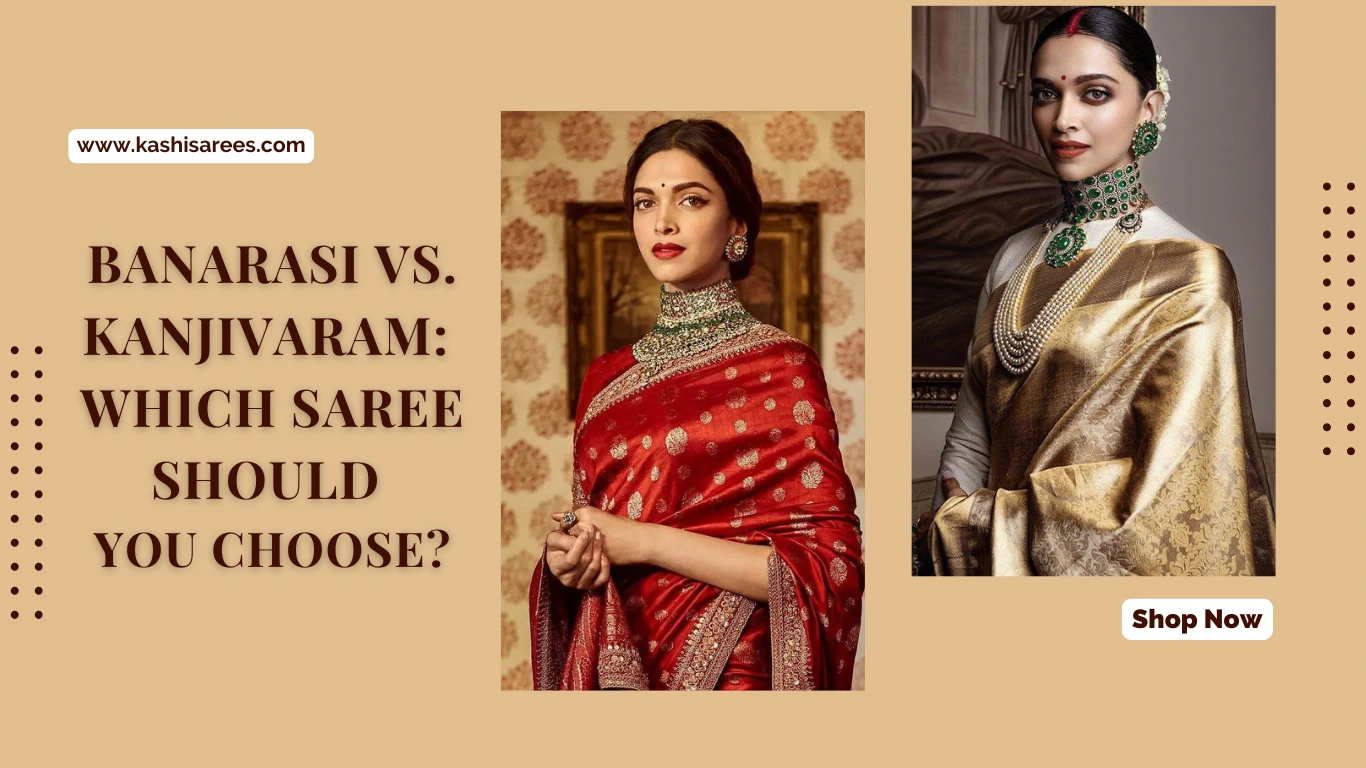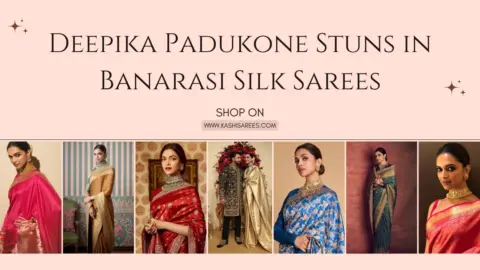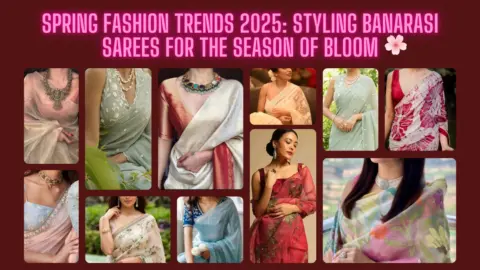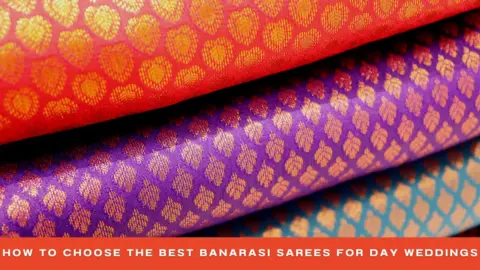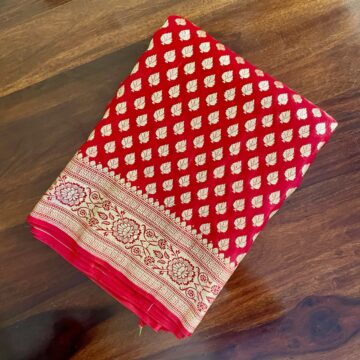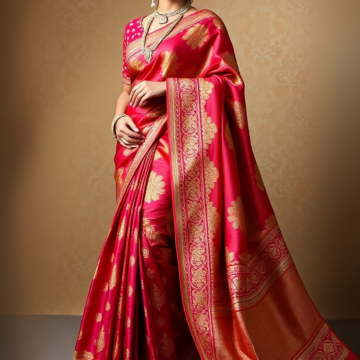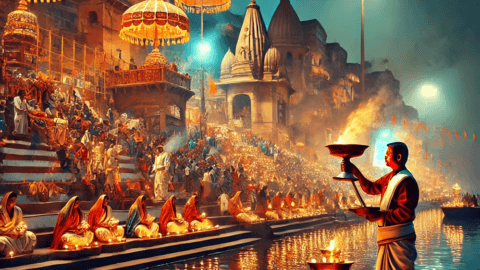Banarasi or Kanjivaram — which saree should you choose for your next big occasion? When it comes to luxurious Indian sarees, these two reign supreme. Both are timeless symbols of elegance, tradition, and craftsmanship—but selecting the right one depends on your style, the event, and your personal preference.
At Kashi Sarees, we often get this question from customers, especially brides and first-time buyers. So, here’s a detailed comparison to help you make the perfect choice between Banarasi and Kanjivaram sarees.
Origin & History
Banarasi Saree:
Originates from Varanasi (Banaras), Uttar Pradesh.
Has roots in Mughal era weaving traditions, especially known for intricate brocade and zari work.
Woven using silk threads, gold/silver zari, and known for floral, foliate, and Mughal-inspired motifs.
Kanjivaram Saree:
Originates from Kanchipuram, Tamil Nadu.
Known as the “Queen of Silks”, this weave has deep Dravidian and temple art influences.
Uses thicker silk yarns, temple borders, checks, peacocks, and mythological motifs.
Fabric & Texture
Banarasi:
Woven using fine Mulberry silk (sometimes blended), with a soft, flowing texture.
Slightly lighter and more fluid in drape, making it easier to wear for long hours.
Kanjivaram:
Made with heavier, high-quality Mulberry silk and three-ply weaving technique.
Has a stiffer and more structured drape with a noticeable weight, often preferred for grand occasions.
Designs & Motifs
Banarasi:
Inspired by Mughal art, featuring kalga, bel, jhallar, and floral jaal motifs.
Known for rich pallu, delicate patterns, and wide ornamental borders.
Often has intricate resha (thread) work and zari highlights.
Kanjivaram:
Temple-inspired designs like gopurams, peacocks, elephants, and mythological scenes.
Contrast borders with thick zari and vibrant hues are a signature.
Patterns are more bold, geometric, and traditional.
Color Palette
Banarasi:
Often available in subtle pastels, rich jewel tones, and dual-tone effects.
More variation in contemporary shades—popular for both festive and modern weddings.
Kanjivaram:
Famous for bold, high-contrast colors—like red-gold, green-pink, purple-orange.
Traditional, regal hues dominate—ideal for grand South Indian weddings.
Occasion Suitability
Banarasi is ideal for:
North Indian weddings
Engagements, receptions, and sangeets
Gifting (lighter varieties)
Festive celebrations (Diwali, Karwa Chauth, Eid)
Kanjivaram is perfect for:
South Indian weddings and traditional rituals
Temple visits and religious ceremonies
Grand events like muhurtham or bridal portraits
Price Range
Banarasi:
Starts from ₹4,000–₹10,000 for lightweight silk blends.
Pure handloom or bridal Banarasis can go from ₹15,000–₹80,000 or more.
Kanjivaram:
Slightly more expensive due to thicker silk and gold zari use.
Starts around ₹8,000 and can go above ₹1,00,000 for bridal or temple-woven pieces.
Maintenance & Care
Banarasi:
Needs gentle dry-cleaning.
Fold carefully along zari lines and store in a muslin cloth.
Avoid hanging for long periods to prevent fabric stress.
Kanjivaram:
Requires more careful folding to protect zari and stiffness.
Store flat or wrapped in cotton fabric.
Dry clean only and keep away from moisture.
Which One Should You Choose?
| Criteria | Choose Banarasi If… | Choose Kanjivaram If… |
|---|---|---|
| Style | You prefer soft, elegant drapes with fine details | You love bold, structured silhouettes |
| Occasion | You’re attending a modern wedding or festive party | You’re a bride or attending a traditional ceremony |
| Region | You’re based in North/Central India | You’re based in South India or love South silks |
| Color Preference | You love pastels, dual-tones, or subtle hues | You prefer rich, bright, high-contrast colors |
| Comfort | You want something lighter and easier to carry | You’re okay with a heavier, regal saree for grandeur |
Final Thoughts
Whether you choose a Banarasi or a Kanjivaram, you’re investing in more than just a saree—you’re embracing heritage, craftsmanship, and elegance that spans generations.
At Kashi Sarees, we offer a curated range of handwoven Banarasi sarees, perfect for every celebration—modern or traditional. And if you’re ever torn between the two, remember: there’s no rule that says you can’t own and love both!
Ready to Explore Banarasi Elegance?
Browse our latest collection at www.kashisarees.com and discover your timeless piece.
#BanarasiVsKanjivaram #KashiSarees #SareeGuide #IndianEthnicWear #BridalSarees #TraditionalWeaves #BanarasiSaree #KanjivaramSaree #SareeComparison #HandloomLove


